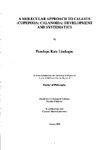A MOLECULAR APPROACH TO CALANUS (COPEPODA:CALANOIDA) DEVELOPMENT AND SYSTEMATICS
| dc.contributor.author | Lindeque, Penelope Kate | |
| dc.contributor.other | School of Biological and Marine Sciences | en_US |
| dc.date.accessioned | 2013-11-06T13:10:21Z | |
| dc.date.available | 2013-11-06T13:10:21Z | |
| dc.date.issued | 2000 | |
| dc.identifier | NOT AVAILABLE | en_US |
| dc.identifier.uri | http://hdl.handle.net/10026.1/2641 | |
| dc.description.abstract |
Production and recruitment measurements in marine copepods of the genus Calanus have been addressed via the study of genes involved in early embryogenesis. The first sequence from a Calanus helgolandicus (C. helgolandicus) developmental gene (Cal-Antp) has been cloned by screening a C. helgolandicus genomic library with a homologous Calanus homeobox probe. Sequencing of an isolated and sub-cloned fragment of this gene, plus further analysis by Inverse Polymerase Chain Reaction (IVPCR), has shown it to be homologous with other Antennapedia homeobox genes. The temporal expression of Cal-Antp was analysed through its messenger RNA (mRNA) complement by Reverse Transcription Polymerase Chain Reaction (RT-PCR). The gene was expressed in tissue taken from eggs over 18 hours old, and in nauplii and copepodite stages, but no expression was detected in eggs less than 18 hours old or adult tissue. Three further homeobox-containing genes have been identified and analysed through their expression in C. helgolandicus eggs. Two of these are caudal homologues, and the third is homologous to the Antennapedia class of genes. The C. helgolandicus developmental gene sequence data provides a means of developing probes to monitor the temporal expression of such genes and their responses to environmental influence. The applicability of such probes to the investigation of key production and recruitment processes, including egg viability measurement, is discussed. A relatively simple and cost effective method has been developed to identify the four Calanus species common to the North Atlantic. This system involves the PCR amplification of a region of the mitochondrial rRNA gene without prior purification of the DNA, followed by Restriction Fragment Length Polymorphism (RFLP) analysis of the amplified product. The versatility of the method is demonstrated by the unambiguous identification to species of any life stage, from egg to adult, and of any individual body parts. The molecular identification technique has for the first time shown the unexpected presence of three different Calanus species in Lurefjorden, Norway and has proved to be consistently accurate for all individuals tested including geographically distinct conspecific populations. | en_US |
| dc.description.sponsorship | Plymouth Marine Laboratory | en_US |
| dc.language.iso | en | en_US |
| dc.publisher | University of Plymouth | en_US |
| dc.title | A MOLECULAR APPROACH TO CALANUS (COPEPODA:CALANOIDA) DEVELOPMENT AND SYSTEMATICS | en_US |
| dc.type | Thesis | |
| plymouth.version | Full version: final and full version as approved by the examiners at the time of the award of your degree | en_US |
| dc.identifier.doi | http://dx.doi.org/10.24382/4825 | |
| dc.identifier.doi | http://dx.doi.org/10.24382/4825 |
Files in this item
This item appears in the following Collection(s)
-
01 Research Theses Main Collection
Research Theses Main


